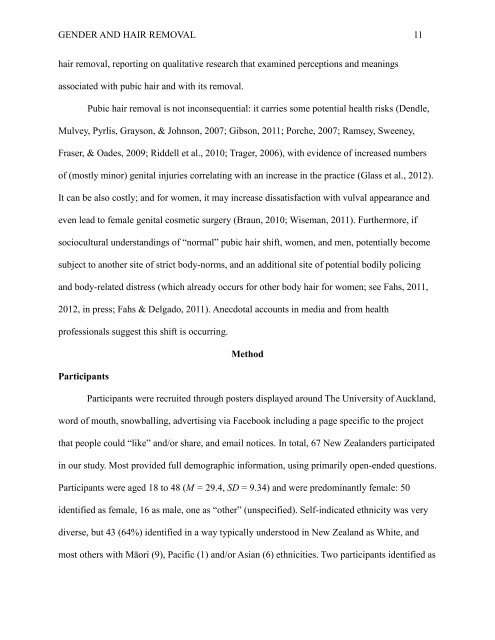Braun, V. , Tricklebank, G. and Clarke, V. (2013) It shouldnt stick out ...
Braun, V. , Tricklebank, G. and Clarke, V. (2013) It shouldnt stick out ...
Braun, V. , Tricklebank, G. and Clarke, V. (2013) It shouldnt stick out ...
Create successful ePaper yourself
Turn your PDF publications into a flip-book with our unique Google optimized e-Paper software.
GENDER AND HAIR REMOVAL 11<br />
hair removal, reporting on qualitative research that examined perceptions <strong>and</strong> meanings<br />
associated with pubic hair <strong>and</strong> with its removal.<br />
Pubic hair removal is not inconsequential: it carries some potential health risks (Dendle,<br />
Mulvey, Pyrlis, Grayson, & Johnson, 2007; Gibson, 2011; Porche, 2007; Ramsey, Sweeney,<br />
Fraser, & Oades, 2009; Riddell et al., 2010; Trager, 2006), with evidence of increased numbers<br />
of (mostly minor) genital injuries correlating with an increase in the practice (Glass et al., 2012).<br />
<strong>It</strong> can be also costly; <strong>and</strong> for women, it may increase dissatisfaction with vulval appearance <strong>and</strong><br />
even lead to female genital cosmetic surgery (<strong>Braun</strong>, 2010; Wiseman, 2011). Furthermore, if<br />
sociocultural underst<strong>and</strong>ings of “normal” pubic hair shift, women, <strong>and</strong> men, potentially become<br />
subject to another site of strict body-norms, <strong>and</strong> an additional site of potential bodily policing<br />
<strong>and</strong> body-related distress (which already occurs for other body hair for women; see Fahs, 2011,<br />
2012, in press; Fahs & Delgado, 2011). Anecdotal accounts in media <strong>and</strong> from health<br />
professionals suggest this shift is occurring.<br />
Participants<br />
Method<br />
Participants were recruited through posters displayed around The University of Auckl<strong>and</strong>,<br />
word of m<strong>out</strong>h, snowballing, advertising via Facebook including a page specific to the project<br />
that people could “like” <strong>and</strong>/or share, <strong>and</strong> email notices. In total, 67 New Zeal<strong>and</strong>ers participated<br />
in our study. Most provided full demographic information, using primarily open-ended questions.<br />
Participants were aged 18 to 48 (M = 29.4, SD = 9.34) <strong>and</strong> were predominantly female: 50<br />
identified as female, 16 as male, one as “other” (unspecified). Self-indicated ethnicity was very<br />
diverse, but 43 (64%) identified in a way typically understood in New Zeal<strong>and</strong> as White, <strong>and</strong><br />
most others with Māori (9), Pacific (1) <strong>and</strong>/or Asian (6) ethnicities. Two participants identified as

















